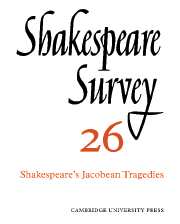Book contents
- Frontmatter
- Studies in Shakespearian and Other Jacobean Tragedy, 1918–1972: A Retrospect
- ‘Form and Cause Conjoin’d’: ‘Hamlet’ and Shakespeare’s Workshop
- The Art of Cruelty: Hamlet and Vindice
- From Tragedy to Tragi-Comedy: ‘King Lear’ as Prologue
- Jacobean Tragedy and the Mannerist Style
- ‘King Lear’ and Doomsday
- Macbeth on Horseback
- Shakespeare’s Misanthrope
- ‘Antony and Cleopatra’ and ‘Coriolanus’, Shakespeare’s Heroic Tragedies: A Jacobean Adjustment
- Shakespeare’s Venus and Adonis Sonnets
- Orlando: Athlete of Virtue
- The Unfolding of ‘Measure for Measure’
- Shakespeare and the Eye
- No Rome of Safety: The Royal Shakespeare Season 1972 Reviewed
- The Year's Contributions to Shakespearian Study 1 Critical Studies
- 2 Shakespeare’s Life, Times, and Stage
- 3 Textual Studies
- Index
- Plate section
‘King Lear’ and Doomsday
Published online by Cambridge University Press: 28 March 2007
- Frontmatter
- Studies in Shakespearian and Other Jacobean Tragedy, 1918–1972: A Retrospect
- ‘Form and Cause Conjoin’d’: ‘Hamlet’ and Shakespeare’s Workshop
- The Art of Cruelty: Hamlet and Vindice
- From Tragedy to Tragi-Comedy: ‘King Lear’ as Prologue
- Jacobean Tragedy and the Mannerist Style
- ‘King Lear’ and Doomsday
- Macbeth on Horseback
- Shakespeare’s Misanthrope
- ‘Antony and Cleopatra’ and ‘Coriolanus’, Shakespeare’s Heroic Tragedies: A Jacobean Adjustment
- Shakespeare’s Venus and Adonis Sonnets
- Orlando: Athlete of Virtue
- The Unfolding of ‘Measure for Measure’
- Shakespeare and the Eye
- No Rome of Safety: The Royal Shakespeare Season 1972 Reviewed
- The Year's Contributions to Shakespearian Study 1 Critical Studies
- 2 Shakespeare’s Life, Times, and Stage
- 3 Textual Studies
- Index
- Plate section
Summary
There are numerous references to Doomsday (the Day of Judgement, the Last Day) in Shakespeare’s plays. Many, at one end of the scale, amount to little more than casual profanity. Some, at the other, are (I believe) significant. By calling these allusions, I hope to designate their character and function. Allusion rests on analogy: it cites a correspondence, in respect of some property or attribute, between this and that. Like metaphor, it has no use for mere similarity: this is a correspondence rather between a pair of shoes than a pair of socks. It will, however, hardly speak home to the imaginative response of an audience if it is too abstruse or too personal: it touches the known, in an unfamiliar way. It should flatter the hearers’ quickness of apprehension, not their patient ingenuity.
Somewhere between mere casual references and allusions heavily charged with significance come passages in which the correspondence between a particular situation and Doomsday denotes a measure of degree or extent. This can be bluntly paraphrased as 'I can't say worse than that, can I?' - o r 'You can't see further than that, can you?' Thus, in i Henry IV, i, i, 29-30, Winchester's tribute to the dead King-
Unto the French the dreadful judgement-day
So dreadful will not be as was his sight
- is a simple rhetorical figure measuring degree of dreadfulness. The Second Murderer's observation on the sleeping Clarence, 'Why, he shall never wake until the great judgement-day' (Richard III, i, iv, 104), though offered as a simple figure of extent - the furthest conceivable point in time - presently discovers unsuspected implications: a prospect of damnation.
- Type
- Chapter
- Information
- Shakespeare Survey , pp. 69 - 80Publisher: Cambridge University PressPrint publication year: 1973
- 2
- Cited by

